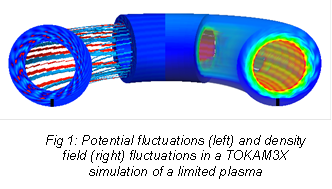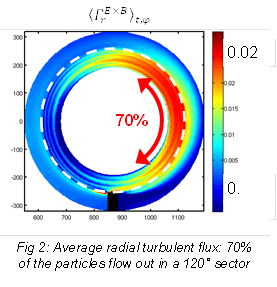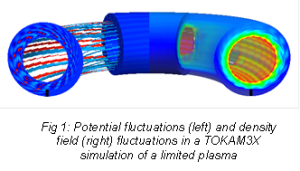The TOKAM3X 3D edge fluid turbulence code has produced its first simulations in quasi-stationary turbulence regime. First results demonstrate the importance of 3D effects in explaining the development of experimentally observed poloidal asymmetries. This stage marks the beginning of the exploitation phase of the code allowing first comparisons with experiments.
Turbulence in the edge plasma of tokamaks is at the heart of two of the main challenges of magnetically controlled fusion research. By determining how well the plasma is confined by the magnetic field in this region where it interacts with the wall, it impacts both the performance of the reactor and the life-expectancy of material components inside the tokamak. In order to study and understand the physical mechanisms at play, one requires numerical codes able to solve complex set of equations. Such effort is led at CEA Cadarache with the development of the TOKAM set of codes.

Started with the TOKAM2D code, which was designed to handle turbulence in a reduced 2D geometry, the project demonstrated the importance of solving turbulent transport without assuming a length scale separation between turbulence and the plasma equilibrium. However, growing experimental evidence as well as results from the 2D simulations themselves progressively showed that a 3D approach is necessary to quantitatively reproduce some of the key features of edge plasma turbulence. This motivated the launch of a new branch of the project with the development of the TOKAM3X code, able to address turbulent transport issues in a realistic toroidal 3D geometry. After 2 years of initial development, the code has now reached a key stage of its development with the first successful simulations of fully established turbulent regime in realistic toroidal limiter geometry, including both open field lines (part of the plasma touching the wall) and the outermost part of the central plasma (see Fig. 1). Simulations demonstrate the importance of 3D effects. In particular, experimentally observed asymmetries of the turbulent particle transport are qualitatively recovered. Such effect is illustrated in Fig. 2 which shows that 70% of the total particle outflux from the central plasma to the open field lines is located in a 120° angular section on the outboard side of the torus. Closer comparison with experimental results from the Tore Supra tokamak (the so-called MISTRAL base case) is currently on-going to assess the model currently implemented in the code.

The TOKAM3X project is now involved in several European collaborations within the Eurofusion framework. Short terms perspective include the application of the code to X-point geometry cases. Development and validation will also be pursued in parallel in order to assess and improve the performances of the code.


